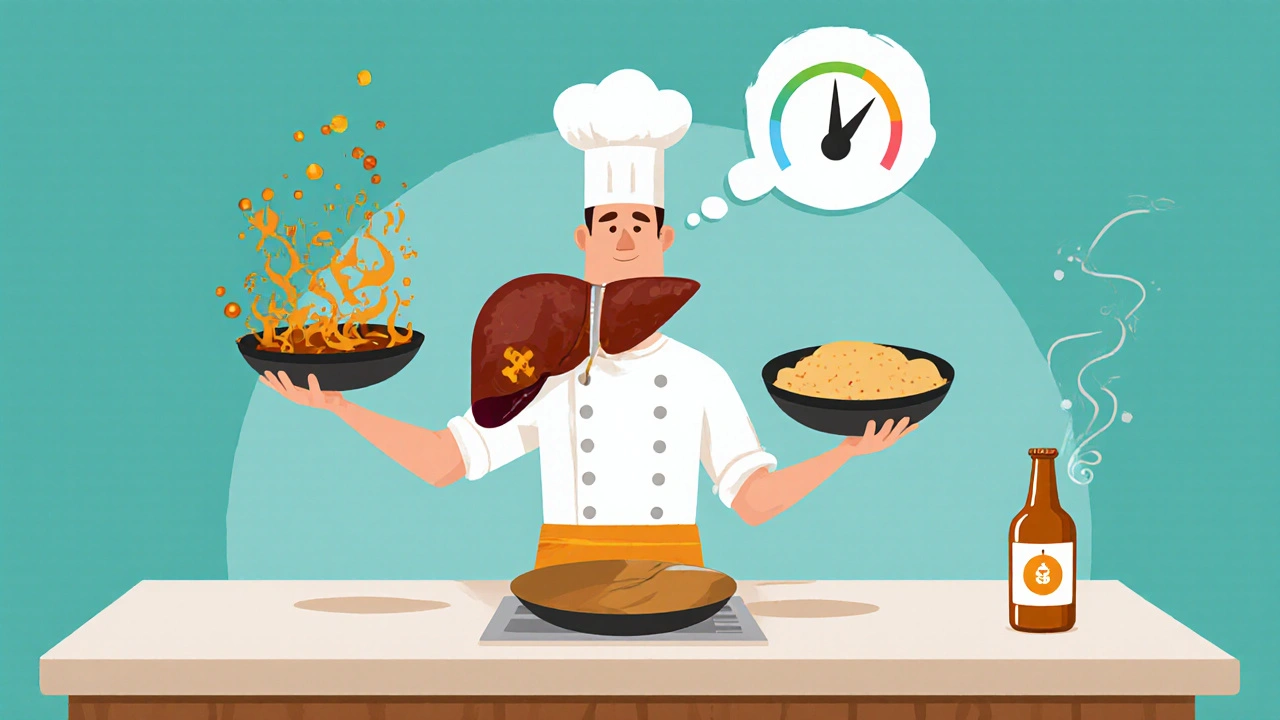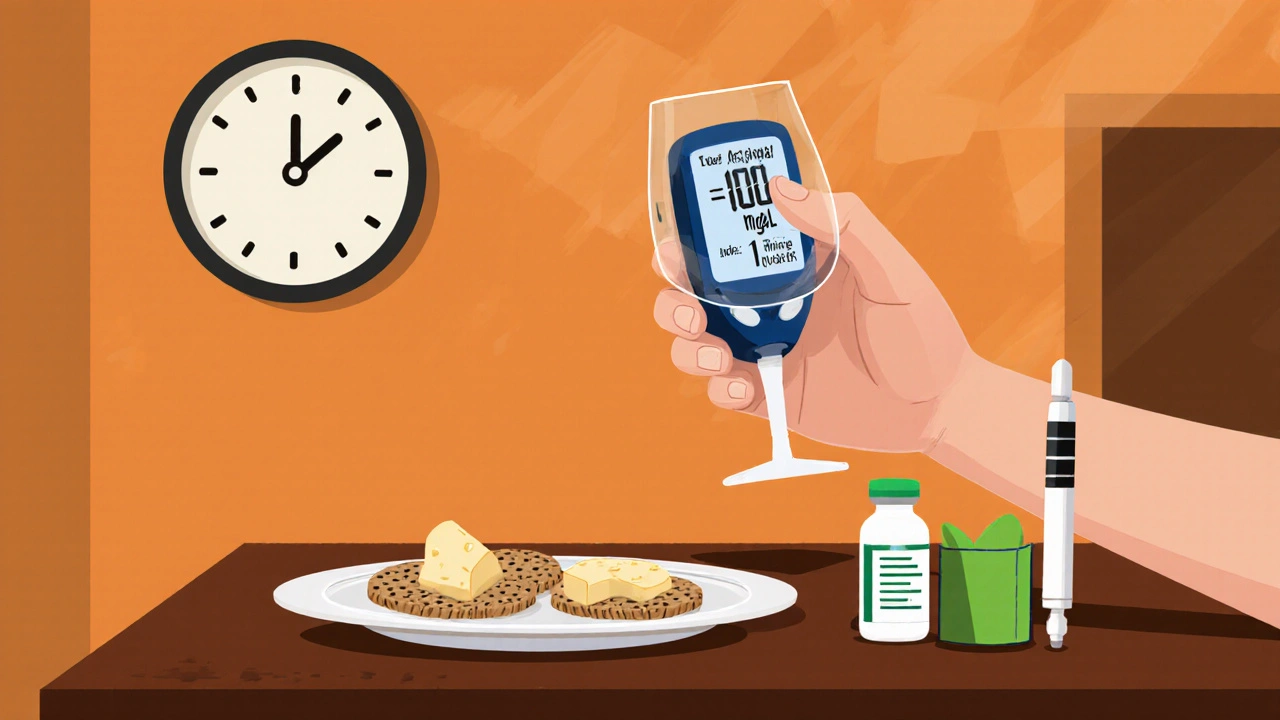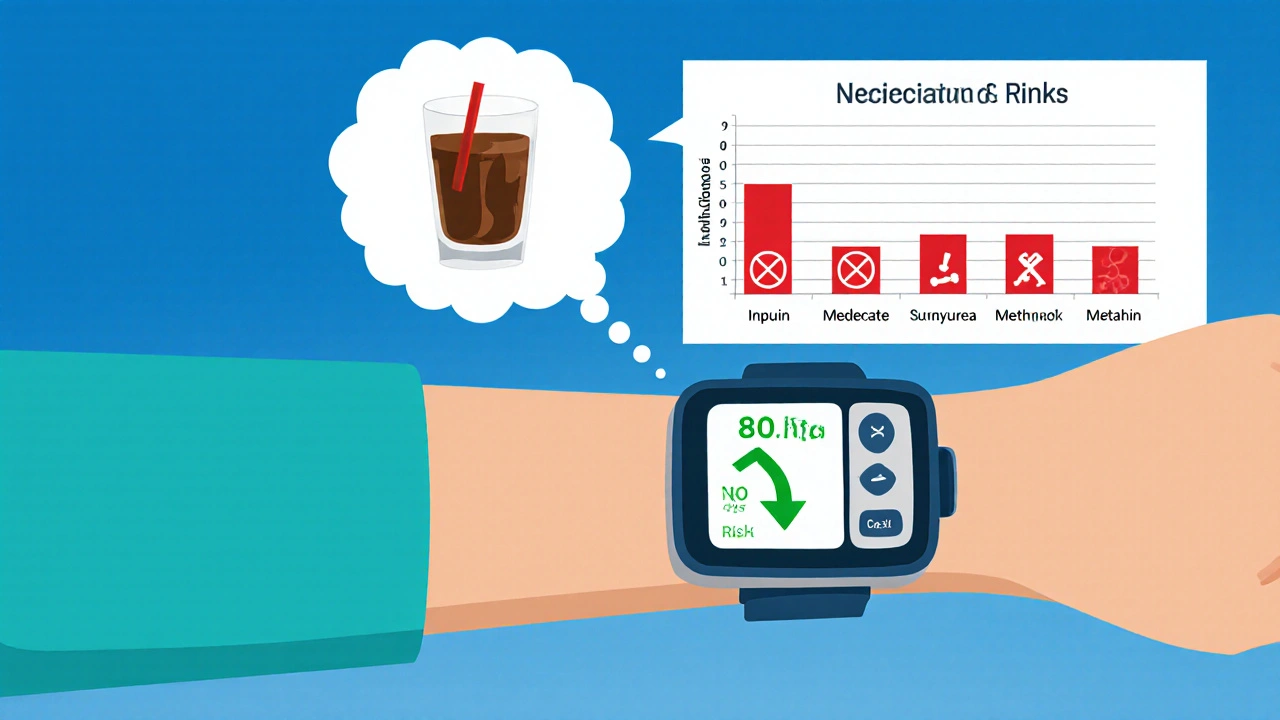Alcohol and Diabetes Medications: How Alcohol Triggers Hypoglycemia & Harms the Liver

Alcohol & Diabetes Medication Interaction Checker
Medication Selection
Select your primary diabetes medication to see alcohol interaction risks and safety recommendations.
Mixing a night out with diabetes meds can feel like walking a tightrope. One slip and you might end up with a dangerous plunge in blood sugar or extra stress on a liver that’s already working overtime. This guide breaks down why Alcohol and diabetes medications don’t always get along, what the science says, and how you can enjoy a drink-if you choose to-without jeopardizing your health.
What happens when you drink while on diabetes meds?
At its core, the problem is a tug‑of‑war inside your liver. The organ has two jobs that clash when alcohol shows up: it has to detoxify ethanol and it has to keep blood glucose steady. When you sip, the liver throws its full attention at the alcohol, temporarily sidelining its glucose‑regulating duties. The result? Blood sugar can drop fast, especially if you’re on meds that already push glucose down.
Alcohol is a psychoactive beverage containing ethanol that the body metabolizes primarily in the liver. When ethanol is present, the liver converts it to acetaldehyde via the enzyme alcohol dehydrogenase, then to acetate. This pathway consumes NAD+, a co‑factor also needed for gluconeogenesis (making new glucose). With NAD+ in short supply, the liver can’t release enough glucose, and hypoglycemia looms.
Diabetes medications are drugs prescribed to lower blood glucose, ranging from insulin injections to oral agents like metformin, sulfonylureas, and newer GLP‑1 agonists. Many of these drugs already increase insulin activity or reduce glucose production, so the added liver distraction amplifies their effects.
Which meds raise the hypoglycemia alarm the most?
Not all diabetes drugs are created equal when it comes to alcohol. The American Diabetes Association (ADA) points out three groups that demand the most caution:
- Insulin - Directly lowers blood sugar; any extra dip can become severe.
- Sulfonylureas (e.g., glipizide, glyburide) - Stimulate the pancreas to release more insulin, magnifying alcohol’s effect.
- Meglitinides - Similar to sulfonylureas but with shorter action; still risky if you drink on an empty stomach.
Oral agents like metformin, while not typically causing low blood sugar, bring their own liver concerns, which we’ll cover next.
Metformin and the liver: a double‑edged sword
Metformin is the most prescribed first‑line drug for type 2 diabetes. It works by reducing hepatic glucose output and improving insulin sensitivity. However, both metformin and alcohol are processed in the liver, often by the same enzyme families-CYP2E1, CYP3A4, and CYP1A2. When you combine them, you can see two kinds of trouble:
- Increased gastrointestinal side effects: nausea, abdominal cramps, and loss of appetite become more pronounced.
- Heightened liver stress: Chronic alcohol use already predisposes you to hepatitis or cirrhosis; adding metformin can accelerate enzyme overload.
Medical News Today notes that moderate drinking (one to two drinks per day) usually won’t cause serious liver injury in otherwise healthy adults, but for people on metformin who already have elevated liver enzymes, even a single binge can push values into the dangerous zone.
Enzyme interactions: why CYP2E1 matters
The cytochrome P450 family is the liver’s chemical workbench. Alcohol induces CYP2E1, which then speeds up the metabolism of some drugs, potentially lowering their therapeutic levels. At the same time, CYP2E1 metabolizes acetaldehyde, a toxic intermediate that can cause oxidative stress and worsen liver inflammation.
For sulfonylureas, the interaction is less about faster clearance and more about competing for the same hepatic resources. When the liver is busy detoxifying ethanol, the normal breakdown of these drugs slows, meaning their blood concentrations stay higher for longer-a recipe for prolonged hypoglycemia.

Practical tips: how to drink safely (if you choose to)
Guidelines differ slightly across organizations, but the core advice converges on three pillars: food, timing, and monitoring.
- Never drink on an empty stomach. Pair each alcoholic beverage with a carbohydrate‑rich snack (e.g., whole‑grain crackers with cheese, a banana, or a small sandwich). This gives the liver a glucose buffer while it processes the alcohol.
- Check your blood sugar before, during, and after drinking. Aim for a baseline above 100 mg/dL. If it falls below 80 mg/dL, skip the next drink.
- Space drinks out. One standard drink per hour gives your liver a chance to clear ethanol before the next dose.
WebMD recommends light beers, dry wines, and plain seltzers because they contain fewer carbs, which helps avoid post‑drink spikes that can mask an upcoming low.
For those on insulin or sulfonylureas, keep a rapid‑acting glucose source (glucose tablets, juice, regular soda) within arm’s reach. If you feel dizzy, shaky, or notice slurred speech, treat it as low blood sugar first-then reassess whether you might also be intoxicated.
Monitoring tools that make a difference
Continuous glucose monitoring (CGM) systems like the Dexcom G7 and Abbott FreeStyle Libre 3 now show trend arrows and alerts that can catch a slow‑creeping drop after a night out. While they don’t detect alcohol directly, the patterns they record (e.g., a dip 4‑6 hours after drinking) give you concrete data to discuss with your clinician.
Many CGM apps let you add notes; tagging a reading with “alcohol” helps you see repeatable trends over weeks. Over time you can fine‑tune your personal risk threshold-perhaps you discover that two drinks are safe on a Saturday night but three push you into a low‑blood‑sugar zone.
When to say “no” to alcohol
Even with careful planning, some situations call for abstinence:
- If you have a history of severe hypoglycemia or hypoglycemia unawareness.
- When liver enzymes (ALT, AST) are already elevated.
- During pregnancy-both alcohol and many diabetes meds carry extra risks for the fetus.
- When you’re on medications that cause alcohol‑intolerance (e.g., disulfiram) or when you’re on high‑dose metformin with renal impairment.
In these cases, the safest bet is to skip the drink entirely and focus on non‑alcoholic alternatives like sparkling water with a splash of citrus.

Key takeaways
Below is a quick reference you can print or save on your phone:
- Alcohol diverts liver resources, making hypoglycemia more likely, especially with insulin, sulfonylureas, or meglitinides.
- Metformin + alcohol = higher gut upset and added liver strain.
- Eat carbs, keep blood sugar >100 mg/dL, and monitor frequently.
- Use CGM trend data to spot delayed lows.
- Avoid alcohol if you have liver disease, severe hypoglycemia history, or are pregnant.
Comparison of medication classes and alcohol‑related risk
| Medication Class | Primary Action | Alcohol‑Induced Hypoglycemia Risk | Liver Stress Potential |
|---|---|---|---|
| Insulin | Directly lowers blood glucose | High - alcohol impairs gluconeogenesis | Low (insulin is not metabolized in liver) |
| Sulfonylureas | Stimulate pancreatic insulin release | High - combined with reduced hepatic glucose output | Moderate - metabolized partly by CYP enzymes |
| Metformin | Decreases hepatic glucose production | Low - does not cause hypoglycemia alone, but risk rises with alcohol‑induced liver diversion | High - both use hepatic pathways, CYP2E1 involvement |
| GLP‑1 agonists | Enhance insulin secretion, slow gastric emptying | Low - minimal direct hypoglycemia | Low - primarily renal clearance |
| DPP‑4 inhibitors | Increase endogenous GLP‑1 | Low | Low - minimal hepatic metabolism |
Frequently Asked Questions
Can I have a glass of wine with my diabetes?
Yes, if you keep your blood sugar above 100 mg/dL, pair the wine with a carb‑rich snack, and monitor levels before and after. Stick to one standard drink and avoid binge drinking.
Why does alcohol cause low blood sugar hours after I stop drinking?
After you finish a drink, the liver continues to prioritize ethanol metabolism. This can suppress gluconeogenesis for up to 12 hours, especially if you’re on insulin or sulfonylureas, leading to delayed hypoglycemia.
Is it safe to take metformin if I occasionally drink?
Occasional moderate drinking (1‑2 drinks) is generally safe, but you should watch for worsening gastrointestinal symptoms and have your liver enzymes checked regularly.
What should I do if I suspect hypoglycemia while intoxicated?
Treat it as low blood sugar first: consume 15‑20 g of fast‑acting carbs (glucose tablets, juice). If symptoms don’t improve in 15 minutes, seek medical help, as you might also be dealing with alcohol poisoning.
Do CGM devices alert me to alcohol‑related lows?
CGMs don’t detect alcohol, but they can flag rapid drops that often follow drinking. Setting a low‑glucose alert (e.g., 80 mg/dL) can warn you in time to treat.

Aaron Kuan
October 25, 2025 AT 15:46Alcohol hijacks your liver’s glucose factory.
Brett Witcher
October 25, 2025 AT 17:10The hepatic competition between ethanol oxidation and gluconeogenesis is well documented. Ethanol metabolism consumes NAD+, thereby limiting the substrate for glucose synthesis. Consequently, patients on insulin or sulfonylureas experience an amplified hypoglycemic response. The article correctly emphasizes the importance of carbohydrate intake when drinking. Clinicians should counsel patients on timing and monitoring to mitigate risk.
Benjamin Sequeira benavente
October 25, 2025 AT 18:33Listen up, if you’re juggling diabetes meds and a night out, you need a game plan!
Your liver is the battlefield where alcohol and glucose fight for attention.
When ethanol shows up, it grabs the spotlight, leaving gluconeogenesis in the shadows.
That means the blood sugar you’ve carefully managed can nosedive in minutes.
Insulin users, especially, should treat every drink like a potential low‑ball surprise.
Sulfonylureas amplify the danger by forcing the pancreas to spew more insulin.
The first rule of the night: never sip on an empty stomach.
Pile on a carb‑rich snack-think whole‑grain crackers, cheese, or a banana-to give your liver a glucose cushion.
Second rule: keep a glucose tablet or a sugary soda within arm’s reach at all times.
If you feel shaky, dizzy, or your vision blurs, drop 15 grams of fast‑acting carbs immediately.
Third rule: pace yourself-one standard drink per hour gives the liver a chance to clear the alcohol.
Use a continuous glucose monitor if you can; those trend arrows are lifesavers.
Tag any drop that follows drinking as “alcohol” in the app so you spot patterns fast.
And remember, moderation isn’t a myth-two drinks on a Saturday can be safe if you stay above 100 mg/dL before the first sip.
Stay sharp, stay proactive, and you’ll keep the party going without a dangerous plunge into hypoglycemia!
Shannon Stoneburgh
October 25, 2025 AT 19:56Alcohol can pull the liver away from making glucose. This is risky if you are on insulin or sulfonylureas. Keep your blood sugar above 100 mg/dL before you drink. Eat a snack and check levels often.
Nathan Comstock
October 25, 2025 AT 21:20Do not be fooled by a casual glass of wine; it is a silent assassin for diabetics.
The liver, overwhelmed by ethanol, abandons its glucose duties.
Your insulin dosage combined with this effect can lead to catastrophic lows.
Even a single binge can push liver enzymes into danger zones.
Respect the science or pay the price.
Terell Moore
October 25, 2025 AT 22:43Ah, the age‑old romance between booze and diabetes-truly a masterpiece of medical irony.
One would think the body could juggle both, yet the liver opts for an outright blackout.
Of course, the guidelines recommend food, timing, and monitoring, pearls of wisdom we all cherish.
It is astonishing that such elementary advice still requires a Reddit post.
Perhaps the next breakthrough will be a cocktail that magically balances glucose.
Until then, enjoy the drama of your own biochemistry.
Amber Lintner
October 26, 2025 AT 00:06Sure, the liver may be a drama queen, but don’t dismiss a modest glass of red wine as pure villainy.
Studies hint at cardiovascular perks that can outweigh a fleeting dip in sugar for some patients.
If you pair it with a hearty meal, the glucose drop becomes negligible.
So before you cast every drink as a criminal, consider the nuance.
Moderation, not abstinence, is the true hero.
Lennox Anoff
October 26, 2025 AT 01:30It is a moral imperative to place health above fleeting pleasure when diabetes is in play.
Choosing to indulge in alcohol while burdened with medications that already strain the liver is a reckless gamble.
The scientific community has repeatedly warned that ethanol consumption diverts hepatic resources essential for glucose homeostasis.
Those who ignore this counsel are effectively signing a waiver for possible hypoglycemic emergencies.
Furthermore, chronic alcohol intake compounds the risk of hepatic injury, especially when paired with agents like metformin that share metabolic pathways.
One could argue that personal freedom is priceless, yet freedom devoid of responsibility is mere hubris.
It is incumbent upon patients, caregivers, and physicians to advocate for informed restraint.
If a celebration calls for a toast, let it be with sparkling water or a non‑alcoholic alternative.
In the end, safeguarding one’s liver and glucose stability is an ethical choice that transcends social expectations.
Olivia Harrison
October 26, 2025 AT 02:53In case you’re looking for practical steps, start by setting a glucose target above 100 mg/dL before any drink.
Keep a small snack handy-cheese sticks or whole‑grain crackers work well.
Carry glucose tablets or a juice box so you can treat a low quickly.
If you have a CGM, enable low‑glucose alerts for extra peace of mind.
And remember, you can always enjoy the company without alcohol if that feels safer for you.
Bianca Larasati
October 26, 2025 AT 03:16Stay empowered, monitor your numbers, and you’ll own the night without fear!
Every smart choice builds confidence for tomorrow’s victories.
Your health is the ultimate party.